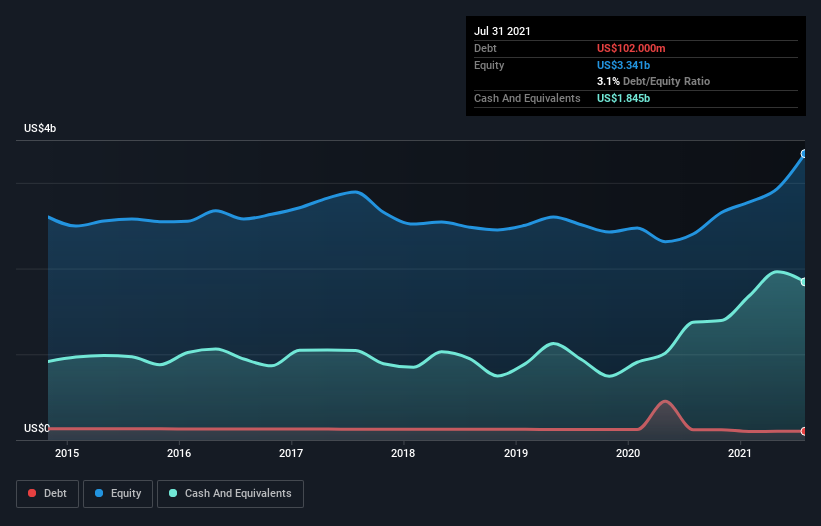Foot Locker (NYSE:FL) Seems To Use Debt Rather Sparingly
Howard Marks put it nicely when he said that, rather than worrying about share price volatility, 'The possibility of permanent loss is the risk I worry about... and every practical investor I know worries about.' So it seems the smart money knows that debt - which is usually involved in bankruptcies - is a very important factor, when you assess how risky a company is. We note that Foot Locker, Inc. (NYSE:FL) does have debt on its balance sheet. But is this debt a concern to shareholders?
When Is Debt A Problem?
Debt is a tool to help businesses grow, but if a business is incapable of paying off its lenders, then it exists at their mercy. In the worst case scenario, a company can go bankrupt if it cannot pay its creditors. While that is not too common, we often do see indebted companies permanently diluting shareholders because lenders force them to raise capital at a distressed price. Of course, plenty of companies use debt to fund growth, without any negative consequences. When we think about a company's use of debt, we first look at cash and debt together.
See our latest analysis for Foot Locker
What Is Foot Locker's Net Debt?
You can click the graphic below for the historical numbers, but it shows that Foot Locker had US$102.0m of debt in July 2021, down from US$121.0m, one year before. But on the other hand it also has US$1.85b in cash, leading to a US$1.74b net cash position.
A Look At Foot Locker's Liabilities
The latest balance sheet data shows that Foot Locker had liabilities of US$1.68b due within a year, and liabilities of US$2.56b falling due after that. On the other hand, it had cash of US$1.85b and US$125.0m worth of receivables due within a year. So its liabilities total US$2.27b more than the combination of its cash and short-term receivables.
Foot Locker has a market capitalization of US$4.91b, so it could very likely raise cash to ameliorate its balance sheet, if the need arose. However, it is still worthwhile taking a close look at its ability to pay off debt. While it does have liabilities worth noting, Foot Locker also has more cash than debt, so we're pretty confident it can manage its debt safely.
Even more impressive was the fact that Foot Locker grew its EBIT by 174% over twelve months. If maintained that growth will make the debt even more manageable in the years ahead. When analysing debt levels, the balance sheet is the obvious place to start. But ultimately the future profitability of the business will decide if Foot Locker can strengthen its balance sheet over time. So if you want to see what the professionals think, you might find this free report on analyst profit forecasts to be interesting.
But our final consideration is also important, because a company cannot pay debt with paper profits; it needs cold hard cash. While Foot Locker has net cash on its balance sheet, it's still worth taking a look at its ability to convert earnings before interest and tax (EBIT) to free cash flow, to help us understand how quickly it is building (or eroding) that cash balance. During the last three years, Foot Locker generated free cash flow amounting to a very robust 98% of its EBIT, more than we'd expect. That puts it in a very strong position to pay down debt.
Summing up
While Foot Locker does have more liabilities than liquid assets, it also has net cash of US$1.74b. And it impressed us with free cash flow of US$695m, being 98% of its EBIT. So is Foot Locker's debt a risk? It doesn't seem so to us. The balance sheet is clearly the area to focus on when you are analysing debt. But ultimately, every company can contain risks that exist outside of the balance sheet. For instance, we've identified 4 warning signs for Foot Locker (2 are potentially serious) you should be aware of.
If you're interested in investing in businesses that can grow profits without the burden of debt, then check out this free list of growing businesses that have net cash on the balance sheet.
This article by Simply Wall St is general in nature. We provide commentary based on historical data and analyst forecasts only using an unbiased methodology and our articles are not intended to be financial advice. It does not constitute a recommendation to buy or sell any stock, and does not take account of your objectives, or your financial situation. We aim to bring you long-term focused analysis driven by fundamental data. Note that our analysis may not factor in the latest price-sensitive company announcements or qualitative material. Simply Wall St has no position in any stocks mentioned.
Have feedback on this article? Concerned about the content? Get in touch with us directly. Alternatively, email editorial-team (at) simplywallst.com.

 Yahoo Finance
Yahoo Finance 
